Exploring Partnership Working in Health and Social Care
VerifiedAdded on 2020/06/03
|13
|4105
|408
AI Summary
This essay delves into the significance of partnership working within health and social care, evaluating how integrated approaches can lead to improved patient outcomes and service efficiency. Drawing from various studies and reviews, it discusses the benefits, challenges, and frameworks necessary for successful partnerships. Key themes include policy implications, user involvement in service design, and the impact of collaborative practices on service delivery. By synthesizing academic literature and practical insights, this essay offers a critical examination of how partnership working can address current gaps within health and social care systems.
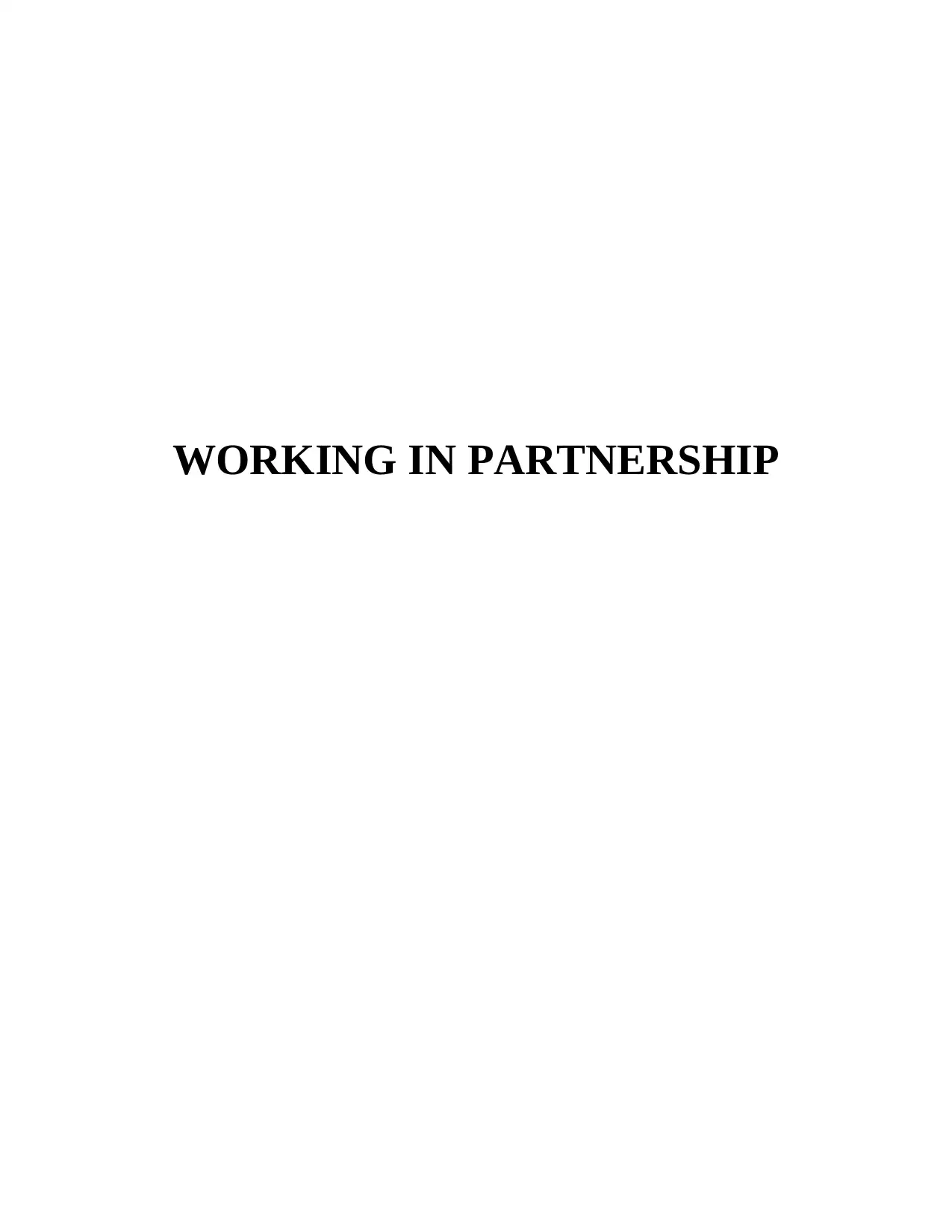
WORKING IN PARTNERSHIP
Paraphrase This Document
Need a fresh take? Get an instant paraphrase of this document with our AI Paraphraser
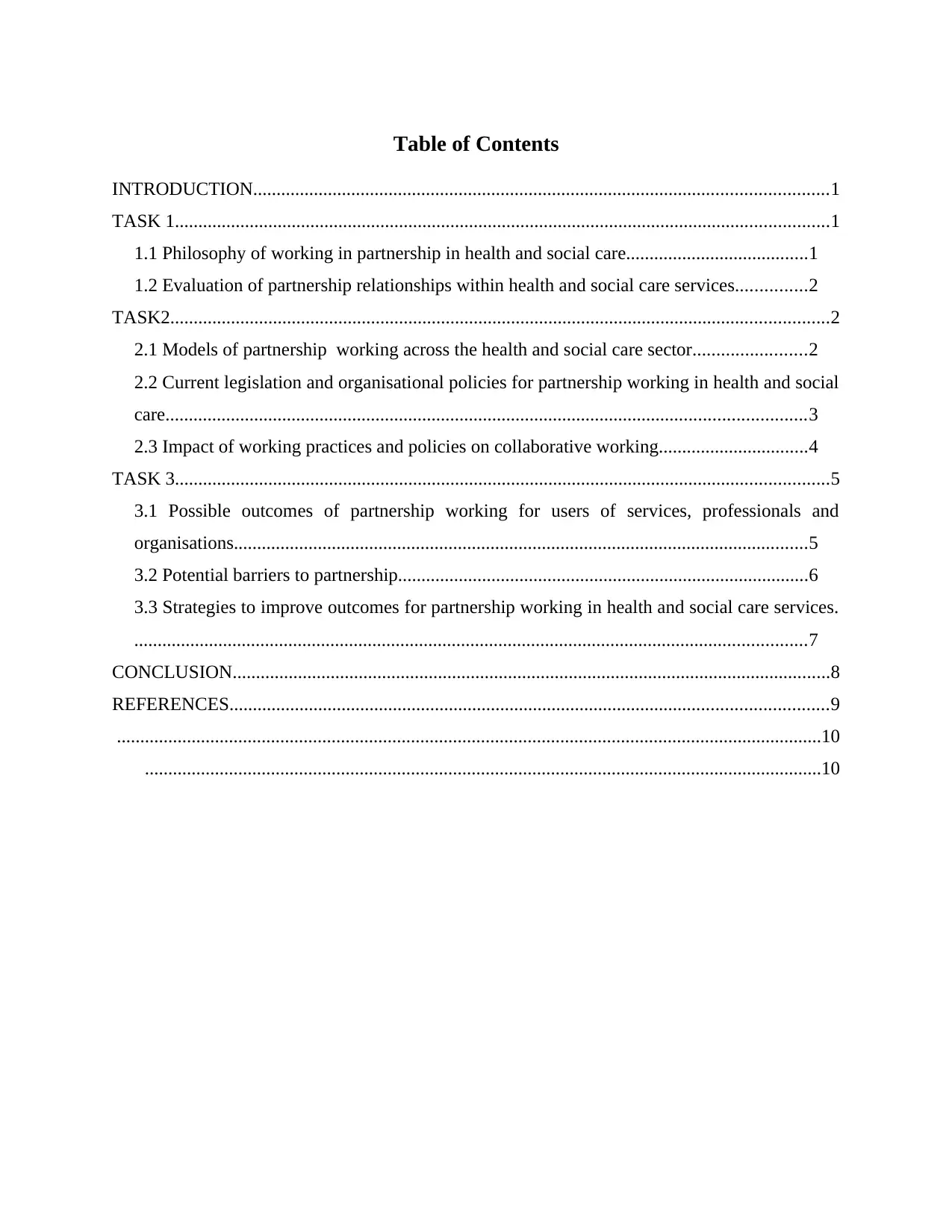
Table of Contents
INTRODUCTION...........................................................................................................................1
TASK 1............................................................................................................................................1
1.1 Philosophy of working in partnership in health and social care.......................................1
1.2 Evaluation of partnership relationships within health and social care services...............2
TASK2.............................................................................................................................................2
2.1 Models of partnership working across the health and social care sector........................2
2.2 Current legislation and organisational policies for partnership working in health and social
care.........................................................................................................................................3
2.3 Impact of working practices and policies on collaborative working................................4
TASK 3............................................................................................................................................5
3.1 Possible outcomes of partnership working for users of services, professionals and
organisations...........................................................................................................................5
3.2 Potential barriers to partnership........................................................................................6
3.3 Strategies to improve outcomes for partnership working in health and social care services.
................................................................................................................................................7
CONCLUSION................................................................................................................................8
REFERENCES................................................................................................................................9
.......................................................................................................................................................10
.................................................................................................................................................10
INTRODUCTION...........................................................................................................................1
TASK 1............................................................................................................................................1
1.1 Philosophy of working in partnership in health and social care.......................................1
1.2 Evaluation of partnership relationships within health and social care services...............2
TASK2.............................................................................................................................................2
2.1 Models of partnership working across the health and social care sector........................2
2.2 Current legislation and organisational policies for partnership working in health and social
care.........................................................................................................................................3
2.3 Impact of working practices and policies on collaborative working................................4
TASK 3............................................................................................................................................5
3.1 Possible outcomes of partnership working for users of services, professionals and
organisations...........................................................................................................................5
3.2 Potential barriers to partnership........................................................................................6
3.3 Strategies to improve outcomes for partnership working in health and social care services.
................................................................................................................................................7
CONCLUSION................................................................................................................................8
REFERENCES................................................................................................................................9
.......................................................................................................................................................10
.................................................................................................................................................10
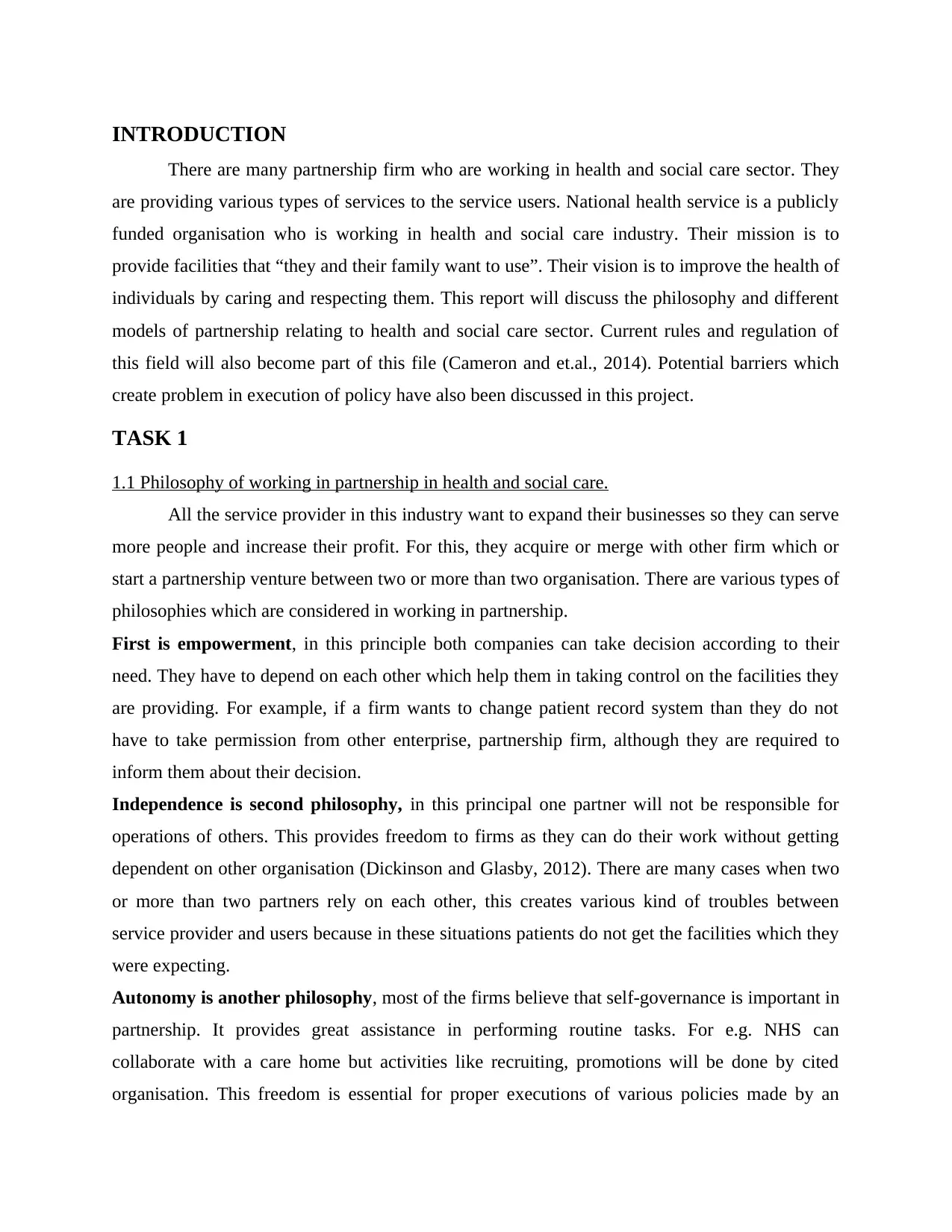
INTRODUCTION
There are many partnership firm who are working in health and social care sector. They
are providing various types of services to the service users. National health service is a publicly
funded organisation who is working in health and social care industry. Their mission is to
provide facilities that “they and their family want to use”. Their vision is to improve the health of
individuals by caring and respecting them. This report will discuss the philosophy and different
models of partnership relating to health and social care sector. Current rules and regulation of
this field will also become part of this file (Cameron and et.al., 2014). Potential barriers which
create problem in execution of policy have also been discussed in this project.
TASK 1
1.1 Philosophy of working in partnership in health and social care.
All the service provider in this industry want to expand their businesses so they can serve
more people and increase their profit. For this, they acquire or merge with other firm which or
start a partnership venture between two or more than two organisation. There are various types of
philosophies which are considered in working in partnership.
First is empowerment, in this principle both companies can take decision according to their
need. They have to depend on each other which help them in taking control on the facilities they
are providing. For example, if a firm wants to change patient record system than they do not
have to take permission from other enterprise, partnership firm, although they are required to
inform them about their decision.
Independence is second philosophy, in this principal one partner will not be responsible for
operations of others. This provides freedom to firms as they can do their work without getting
dependent on other organisation (Dickinson and Glasby, 2012). There are many cases when two
or more than two partners rely on each other, this creates various kind of troubles between
service provider and users because in these situations patients do not get the facilities which they
were expecting.
Autonomy is another philosophy, most of the firms believe that self-governance is important in
partnership. It provides great assistance in performing routine tasks. For e.g. NHS can
collaborate with a care home but activities like recruiting, promotions will be done by cited
organisation. This freedom is essential for proper executions of various policies made by an
There are many partnership firm who are working in health and social care sector. They
are providing various types of services to the service users. National health service is a publicly
funded organisation who is working in health and social care industry. Their mission is to
provide facilities that “they and their family want to use”. Their vision is to improve the health of
individuals by caring and respecting them. This report will discuss the philosophy and different
models of partnership relating to health and social care sector. Current rules and regulation of
this field will also become part of this file (Cameron and et.al., 2014). Potential barriers which
create problem in execution of policy have also been discussed in this project.
TASK 1
1.1 Philosophy of working in partnership in health and social care.
All the service provider in this industry want to expand their businesses so they can serve
more people and increase their profit. For this, they acquire or merge with other firm which or
start a partnership venture between two or more than two organisation. There are various types of
philosophies which are considered in working in partnership.
First is empowerment, in this principle both companies can take decision according to their
need. They have to depend on each other which help them in taking control on the facilities they
are providing. For example, if a firm wants to change patient record system than they do not
have to take permission from other enterprise, partnership firm, although they are required to
inform them about their decision.
Independence is second philosophy, in this principal one partner will not be responsible for
operations of others. This provides freedom to firms as they can do their work without getting
dependent on other organisation (Dickinson and Glasby, 2012). There are many cases when two
or more than two partners rely on each other, this creates various kind of troubles between
service provider and users because in these situations patients do not get the facilities which they
were expecting.
Autonomy is another philosophy, most of the firms believe that self-governance is important in
partnership. It provides great assistance in performing routine tasks. For e.g. NHS can
collaborate with a care home but activities like recruiting, promotions will be done by cited
organisation. This freedom is essential for proper executions of various policies made by an
⊘ This is a preview!⊘
Do you want full access?
Subscribe today to unlock all pages.

Trusted by 1+ million students worldwide
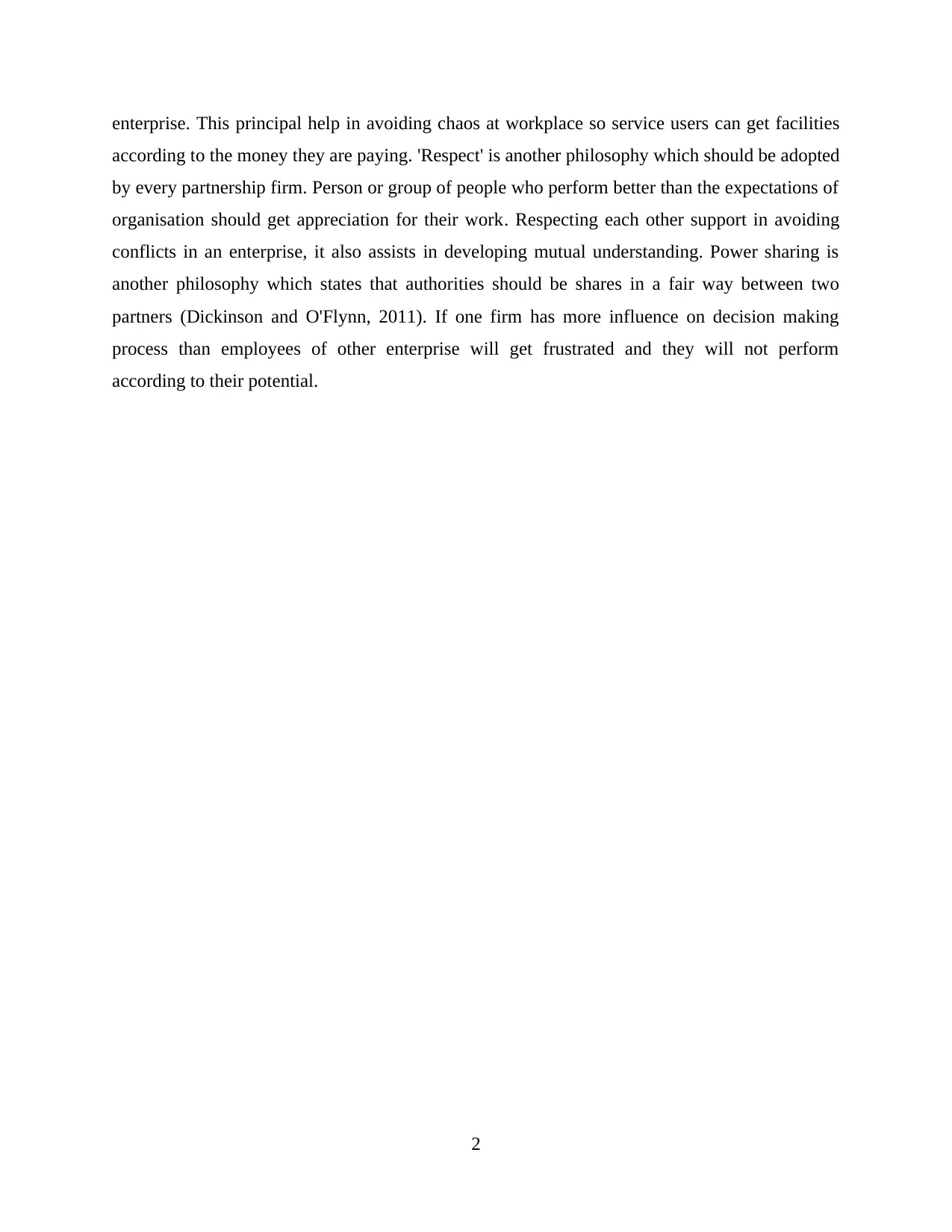
enterprise. This principal help in avoiding chaos at workplace so service users can get facilities
according to the money they are paying. 'Respect' is another philosophy which should be adopted
by every partnership firm. Person or group of people who perform better than the expectations of
organisation should get appreciation for their work. Respecting each other support in avoiding
conflicts in an enterprise, it also assists in developing mutual understanding. Power sharing is
another philosophy which states that authorities should be shares in a fair way between two
partners (Dickinson and O'Flynn, 2011). If one firm has more influence on decision making
process than employees of other enterprise will get frustrated and they will not perform
according to their potential.
2
according to the money they are paying. 'Respect' is another philosophy which should be adopted
by every partnership firm. Person or group of people who perform better than the expectations of
organisation should get appreciation for their work. Respecting each other support in avoiding
conflicts in an enterprise, it also assists in developing mutual understanding. Power sharing is
another philosophy which states that authorities should be shares in a fair way between two
partners (Dickinson and O'Flynn, 2011). If one firm has more influence on decision making
process than employees of other enterprise will get frustrated and they will not perform
according to their potential.
2
Paraphrase This Document
Need a fresh take? Get an instant paraphrase of this document with our AI Paraphraser
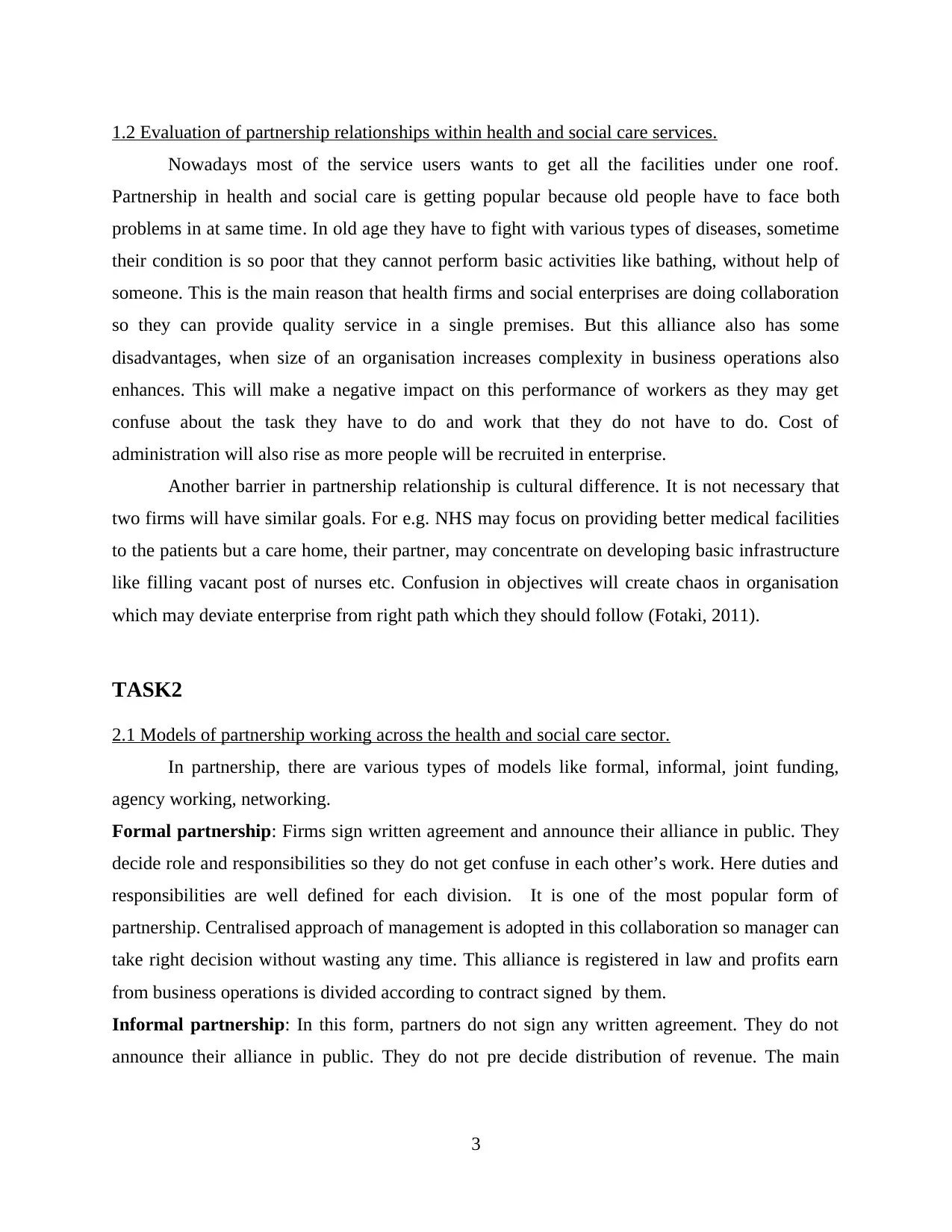
1.2 Evaluation of partnership relationships within health and social care services.
Nowadays most of the service users wants to get all the facilities under one roof.
Partnership in health and social care is getting popular because old people have to face both
problems in at same time. In old age they have to fight with various types of diseases, sometime
their condition is so poor that they cannot perform basic activities like bathing, without help of
someone. This is the main reason that health firms and social enterprises are doing collaboration
so they can provide quality service in a single premises. But this alliance also has some
disadvantages, when size of an organisation increases complexity in business operations also
enhances. This will make a negative impact on this performance of workers as they may get
confuse about the task they have to do and work that they do not have to do. Cost of
administration will also rise as more people will be recruited in enterprise.
Another barrier in partnership relationship is cultural difference. It is not necessary that
two firms will have similar goals. For e.g. NHS may focus on providing better medical facilities
to the patients but a care home, their partner, may concentrate on developing basic infrastructure
like filling vacant post of nurses etc. Confusion in objectives will create chaos in organisation
which may deviate enterprise from right path which they should follow (Fotaki, 2011).
TASK2
2.1 Models of partnership working across the health and social care sector.
In partnership, there are various types of models like formal, informal, joint funding,
agency working, networking.
Formal partnership: Firms sign written agreement and announce their alliance in public. They
decide role and responsibilities so they do not get confuse in each other’s work. Here duties and
responsibilities are well defined for each division. It is one of the most popular form of
partnership. Centralised approach of management is adopted in this collaboration so manager can
take right decision without wasting any time. This alliance is registered in law and profits earn
from business operations is divided according to contract signed by them.
Informal partnership: In this form, partners do not sign any written agreement. They do not
announce their alliance in public. They do not pre decide distribution of revenue. The main
3
Nowadays most of the service users wants to get all the facilities under one roof.
Partnership in health and social care is getting popular because old people have to face both
problems in at same time. In old age they have to fight with various types of diseases, sometime
their condition is so poor that they cannot perform basic activities like bathing, without help of
someone. This is the main reason that health firms and social enterprises are doing collaboration
so they can provide quality service in a single premises. But this alliance also has some
disadvantages, when size of an organisation increases complexity in business operations also
enhances. This will make a negative impact on this performance of workers as they may get
confuse about the task they have to do and work that they do not have to do. Cost of
administration will also rise as more people will be recruited in enterprise.
Another barrier in partnership relationship is cultural difference. It is not necessary that
two firms will have similar goals. For e.g. NHS may focus on providing better medical facilities
to the patients but a care home, their partner, may concentrate on developing basic infrastructure
like filling vacant post of nurses etc. Confusion in objectives will create chaos in organisation
which may deviate enterprise from right path which they should follow (Fotaki, 2011).
TASK2
2.1 Models of partnership working across the health and social care sector.
In partnership, there are various types of models like formal, informal, joint funding,
agency working, networking.
Formal partnership: Firms sign written agreement and announce their alliance in public. They
decide role and responsibilities so they do not get confuse in each other’s work. Here duties and
responsibilities are well defined for each division. It is one of the most popular form of
partnership. Centralised approach of management is adopted in this collaboration so manager can
take right decision without wasting any time. This alliance is registered in law and profits earn
from business operations is divided according to contract signed by them.
Informal partnership: In this form, partners do not sign any written agreement. They do not
announce their alliance in public. They do not pre decide distribution of revenue. The main
3
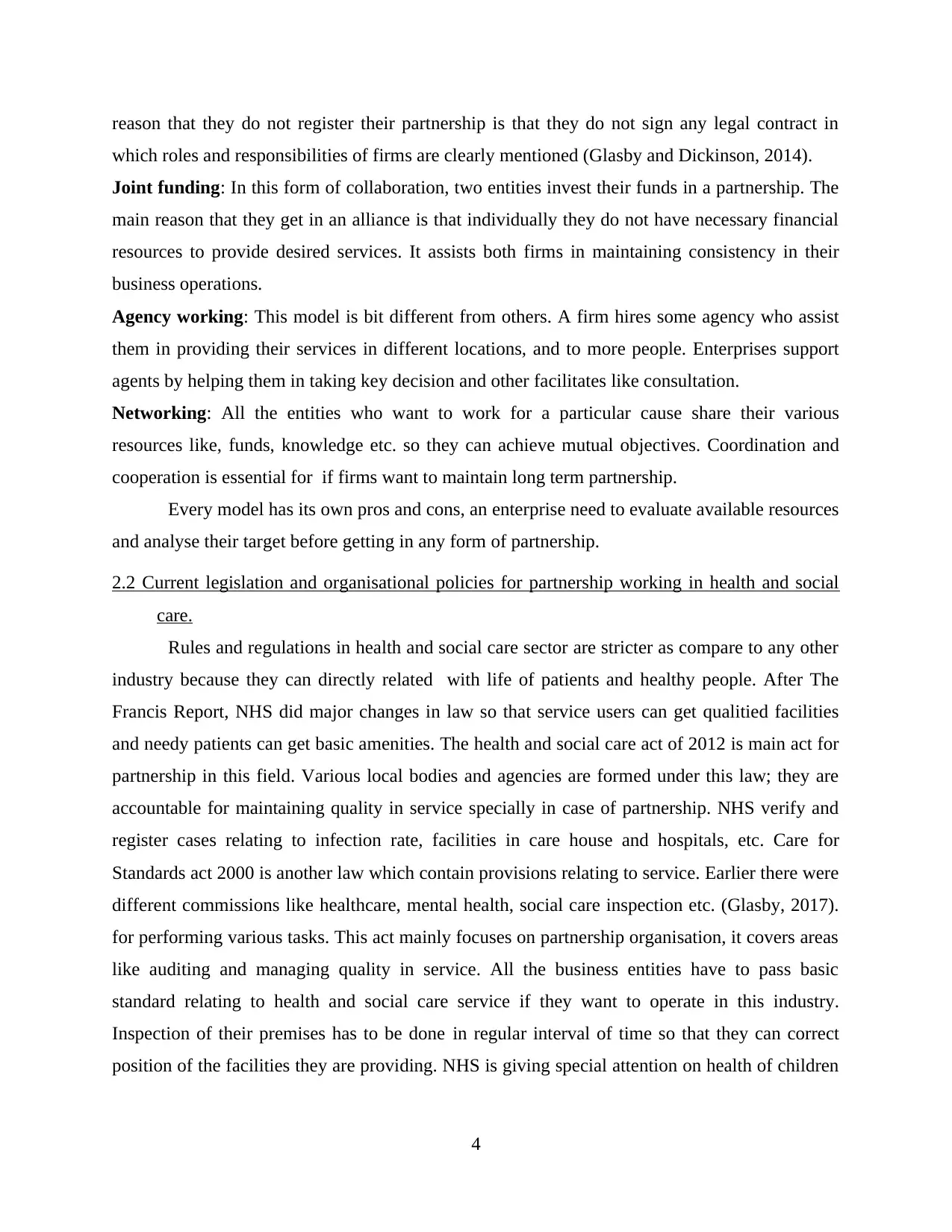
reason that they do not register their partnership is that they do not sign any legal contract in
which roles and responsibilities of firms are clearly mentioned (Glasby and Dickinson, 2014).
Joint funding: In this form of collaboration, two entities invest their funds in a partnership. The
main reason that they get in an alliance is that individually they do not have necessary financial
resources to provide desired services. It assists both firms in maintaining consistency in their
business operations.
Agency working: This model is bit different from others. A firm hires some agency who assist
them in providing their services in different locations, and to more people. Enterprises support
agents by helping them in taking key decision and other facilitates like consultation.
Networking: All the entities who want to work for a particular cause share their various
resources like, funds, knowledge etc. so they can achieve mutual objectives. Coordination and
cooperation is essential for if firms want to maintain long term partnership.
Every model has its own pros and cons, an enterprise need to evaluate available resources
and analyse their target before getting in any form of partnership.
2.2 Current legislation and organisational policies for partnership working in health and social
care.
Rules and regulations in health and social care sector are stricter as compare to any other
industry because they can directly related with life of patients and healthy people. After The
Francis Report, NHS did major changes in law so that service users can get qualitied facilities
and needy patients can get basic amenities. The health and social care act of 2012 is main act for
partnership in this field. Various local bodies and agencies are formed under this law; they are
accountable for maintaining quality in service specially in case of partnership. NHS verify and
register cases relating to infection rate, facilities in care house and hospitals, etc. Care for
Standards act 2000 is another law which contain provisions relating to service. Earlier there were
different commissions like healthcare, mental health, social care inspection etc. (Glasby, 2017).
for performing various tasks. This act mainly focuses on partnership organisation, it covers areas
like auditing and managing quality in service. All the business entities have to pass basic
standard relating to health and social care service if they want to operate in this industry.
Inspection of their premises has to be done in regular interval of time so that they can correct
position of the facilities they are providing. NHS is giving special attention on health of children
4
which roles and responsibilities of firms are clearly mentioned (Glasby and Dickinson, 2014).
Joint funding: In this form of collaboration, two entities invest their funds in a partnership. The
main reason that they get in an alliance is that individually they do not have necessary financial
resources to provide desired services. It assists both firms in maintaining consistency in their
business operations.
Agency working: This model is bit different from others. A firm hires some agency who assist
them in providing their services in different locations, and to more people. Enterprises support
agents by helping them in taking key decision and other facilitates like consultation.
Networking: All the entities who want to work for a particular cause share their various
resources like, funds, knowledge etc. so they can achieve mutual objectives. Coordination and
cooperation is essential for if firms want to maintain long term partnership.
Every model has its own pros and cons, an enterprise need to evaluate available resources
and analyse their target before getting in any form of partnership.
2.2 Current legislation and organisational policies for partnership working in health and social
care.
Rules and regulations in health and social care sector are stricter as compare to any other
industry because they can directly related with life of patients and healthy people. After The
Francis Report, NHS did major changes in law so that service users can get qualitied facilities
and needy patients can get basic amenities. The health and social care act of 2012 is main act for
partnership in this field. Various local bodies and agencies are formed under this law; they are
accountable for maintaining quality in service specially in case of partnership. NHS verify and
register cases relating to infection rate, facilities in care house and hospitals, etc. Care for
Standards act 2000 is another law which contain provisions relating to service. Earlier there were
different commissions like healthcare, mental health, social care inspection etc. (Glasby, 2017).
for performing various tasks. This act mainly focuses on partnership organisation, it covers areas
like auditing and managing quality in service. All the business entities have to pass basic
standard relating to health and social care service if they want to operate in this industry.
Inspection of their premises has to be done in regular interval of time so that they can correct
position of the facilities they are providing. NHS is giving special attention on health of children
4
⊘ This is a preview!⊘
Do you want full access?
Subscribe today to unlock all pages.

Trusted by 1+ million students worldwide
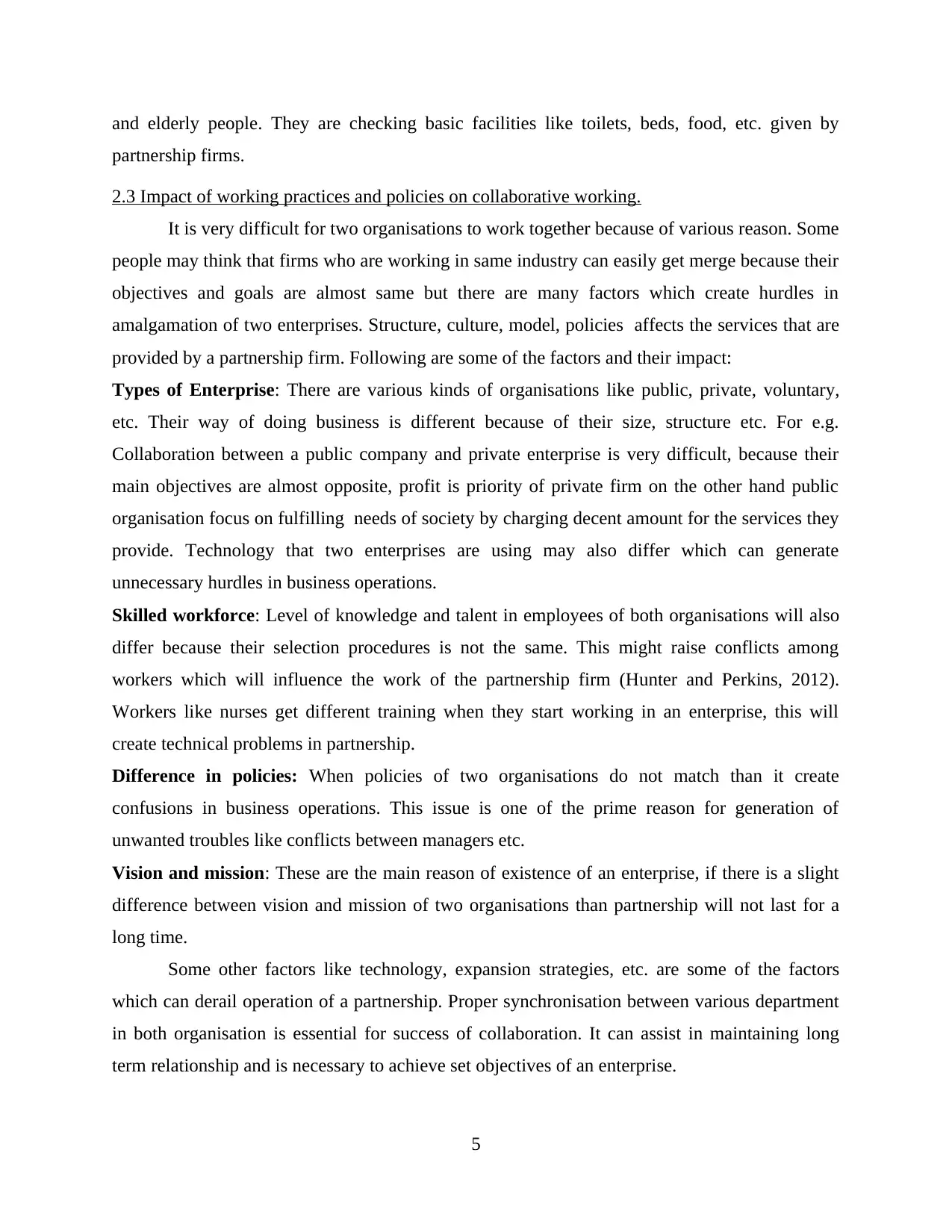
and elderly people. They are checking basic facilities like toilets, beds, food, etc. given by
partnership firms.
2.3 Impact of working practices and policies on collaborative working.
It is very difficult for two organisations to work together because of various reason. Some
people may think that firms who are working in same industry can easily get merge because their
objectives and goals are almost same but there are many factors which create hurdles in
amalgamation of two enterprises. Structure, culture, model, policies affects the services that are
provided by a partnership firm. Following are some of the factors and their impact:
Types of Enterprise: There are various kinds of organisations like public, private, voluntary,
etc. Their way of doing business is different because of their size, structure etc. For e.g.
Collaboration between a public company and private enterprise is very difficult, because their
main objectives are almost opposite, profit is priority of private firm on the other hand public
organisation focus on fulfilling needs of society by charging decent amount for the services they
provide. Technology that two enterprises are using may also differ which can generate
unnecessary hurdles in business operations.
Skilled workforce: Level of knowledge and talent in employees of both organisations will also
differ because their selection procedures is not the same. This might raise conflicts among
workers which will influence the work of the partnership firm (Hunter and Perkins, 2012).
Workers like nurses get different training when they start working in an enterprise, this will
create technical problems in partnership.
Difference in policies: When policies of two organisations do not match than it create
confusions in business operations. This issue is one of the prime reason for generation of
unwanted troubles like conflicts between managers etc.
Vision and mission: These are the main reason of existence of an enterprise, if there is a slight
difference between vision and mission of two organisations than partnership will not last for a
long time.
Some other factors like technology, expansion strategies, etc. are some of the factors
which can derail operation of a partnership. Proper synchronisation between various department
in both organisation is essential for success of collaboration. It can assist in maintaining long
term relationship and is necessary to achieve set objectives of an enterprise.
5
partnership firms.
2.3 Impact of working practices and policies on collaborative working.
It is very difficult for two organisations to work together because of various reason. Some
people may think that firms who are working in same industry can easily get merge because their
objectives and goals are almost same but there are many factors which create hurdles in
amalgamation of two enterprises. Structure, culture, model, policies affects the services that are
provided by a partnership firm. Following are some of the factors and their impact:
Types of Enterprise: There are various kinds of organisations like public, private, voluntary,
etc. Their way of doing business is different because of their size, structure etc. For e.g.
Collaboration between a public company and private enterprise is very difficult, because their
main objectives are almost opposite, profit is priority of private firm on the other hand public
organisation focus on fulfilling needs of society by charging decent amount for the services they
provide. Technology that two enterprises are using may also differ which can generate
unnecessary hurdles in business operations.
Skilled workforce: Level of knowledge and talent in employees of both organisations will also
differ because their selection procedures is not the same. This might raise conflicts among
workers which will influence the work of the partnership firm (Hunter and Perkins, 2012).
Workers like nurses get different training when they start working in an enterprise, this will
create technical problems in partnership.
Difference in policies: When policies of two organisations do not match than it create
confusions in business operations. This issue is one of the prime reason for generation of
unwanted troubles like conflicts between managers etc.
Vision and mission: These are the main reason of existence of an enterprise, if there is a slight
difference between vision and mission of two organisations than partnership will not last for a
long time.
Some other factors like technology, expansion strategies, etc. are some of the factors
which can derail operation of a partnership. Proper synchronisation between various department
in both organisation is essential for success of collaboration. It can assist in maintaining long
term relationship and is necessary to achieve set objectives of an enterprise.
5
Paraphrase This Document
Need a fresh take? Get an instant paraphrase of this document with our AI Paraphraser
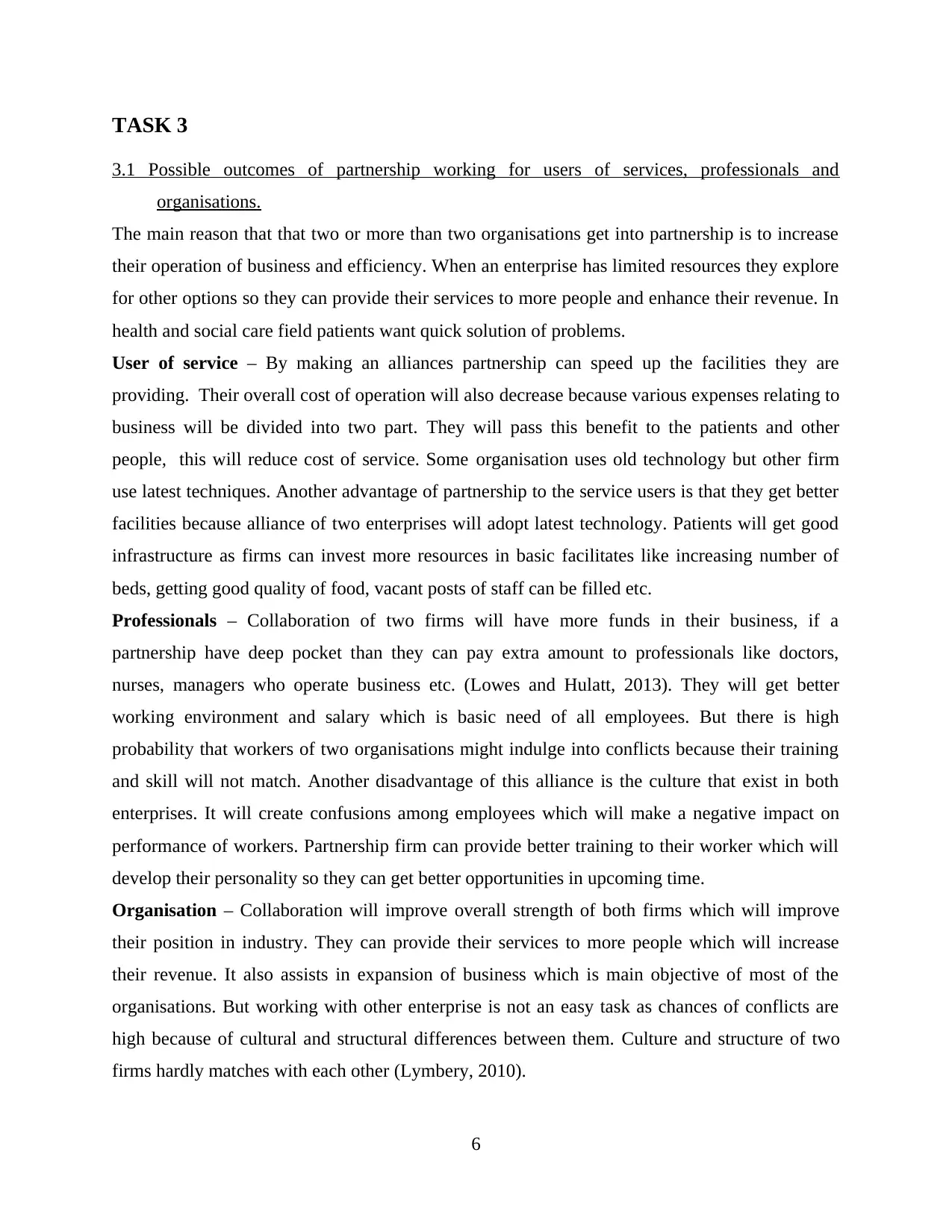
TASK 3
3.1 Possible outcomes of partnership working for users of services, professionals and
organisations.
The main reason that that two or more than two organisations get into partnership is to increase
their operation of business and efficiency. When an enterprise has limited resources they explore
for other options so they can provide their services to more people and enhance their revenue. In
health and social care field patients want quick solution of problems.
User of service – By making an alliances partnership can speed up the facilities they are
providing. Their overall cost of operation will also decrease because various expenses relating to
business will be divided into two part. They will pass this benefit to the patients and other
people, this will reduce cost of service. Some organisation uses old technology but other firm
use latest techniques. Another advantage of partnership to the service users is that they get better
facilities because alliance of two enterprises will adopt latest technology. Patients will get good
infrastructure as firms can invest more resources in basic facilitates like increasing number of
beds, getting good quality of food, vacant posts of staff can be filled etc.
Professionals – Collaboration of two firms will have more funds in their business, if a
partnership have deep pocket than they can pay extra amount to professionals like doctors,
nurses, managers who operate business etc. (Lowes and Hulatt, 2013). They will get better
working environment and salary which is basic need of all employees. But there is high
probability that workers of two organisations might indulge into conflicts because their training
and skill will not match. Another disadvantage of this alliance is the culture that exist in both
enterprises. It will create confusions among employees which will make a negative impact on
performance of workers. Partnership firm can provide better training to their worker which will
develop their personality so they can get better opportunities in upcoming time.
Organisation – Collaboration will improve overall strength of both firms which will improve
their position in industry. They can provide their services to more people which will increase
their revenue. It also assists in expansion of business which is main objective of most of the
organisations. But working with other enterprise is not an easy task as chances of conflicts are
high because of cultural and structural differences between them. Culture and structure of two
firms hardly matches with each other (Lymbery, 2010).
6
3.1 Possible outcomes of partnership working for users of services, professionals and
organisations.
The main reason that that two or more than two organisations get into partnership is to increase
their operation of business and efficiency. When an enterprise has limited resources they explore
for other options so they can provide their services to more people and enhance their revenue. In
health and social care field patients want quick solution of problems.
User of service – By making an alliances partnership can speed up the facilities they are
providing. Their overall cost of operation will also decrease because various expenses relating to
business will be divided into two part. They will pass this benefit to the patients and other
people, this will reduce cost of service. Some organisation uses old technology but other firm
use latest techniques. Another advantage of partnership to the service users is that they get better
facilities because alliance of two enterprises will adopt latest technology. Patients will get good
infrastructure as firms can invest more resources in basic facilitates like increasing number of
beds, getting good quality of food, vacant posts of staff can be filled etc.
Professionals – Collaboration of two firms will have more funds in their business, if a
partnership have deep pocket than they can pay extra amount to professionals like doctors,
nurses, managers who operate business etc. (Lowes and Hulatt, 2013). They will get better
working environment and salary which is basic need of all employees. But there is high
probability that workers of two organisations might indulge into conflicts because their training
and skill will not match. Another disadvantage of this alliance is the culture that exist in both
enterprises. It will create confusions among employees which will make a negative impact on
performance of workers. Partnership firm can provide better training to their worker which will
develop their personality so they can get better opportunities in upcoming time.
Organisation – Collaboration will improve overall strength of both firms which will improve
their position in industry. They can provide their services to more people which will increase
their revenue. It also assists in expansion of business which is main objective of most of the
organisations. But working with other enterprise is not an easy task as chances of conflicts are
high because of cultural and structural differences between them. Culture and structure of two
firms hardly matches with each other (Lymbery, 2010).
6
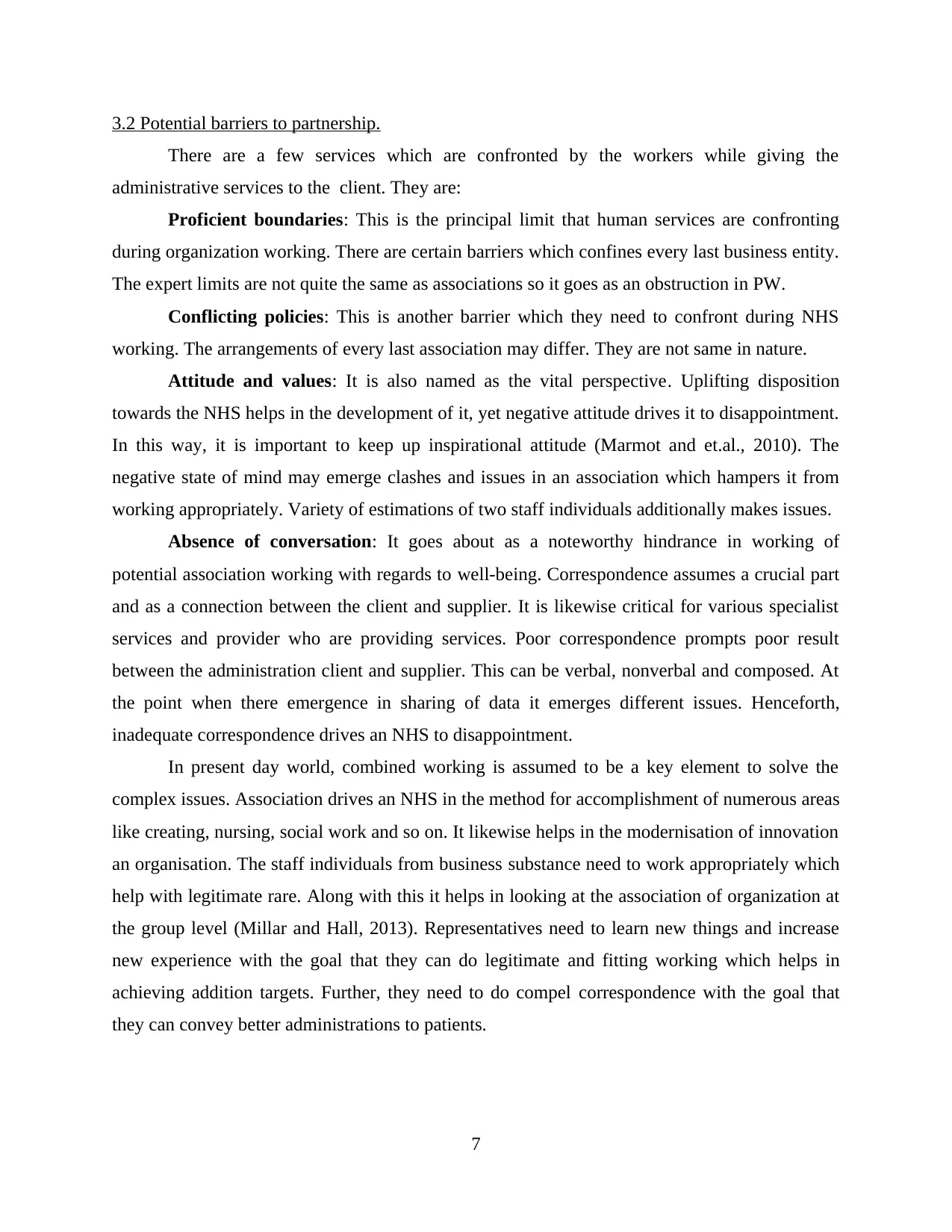
3.2 Potential barriers to partnership.
There are a few services which are confronted by the workers while giving the
administrative services to the client. They are:
Proficient boundaries: This is the principal limit that human services are confronting
during organization working. There are certain barriers which confines every last business entity.
The expert limits are not quite the same as associations so it goes as an obstruction in PW.
Conflicting policies: This is another barrier which they need to confront during NHS
working. The arrangements of every last association may differ. They are not same in nature.
Attitude and values: It is also named as the vital perspective. Uplifting disposition
towards the NHS helps in the development of it, yet negative attitude drives it to disappointment.
In this way, it is important to keep up inspirational attitude (Marmot and et.al., 2010). The
negative state of mind may emerge clashes and issues in an association which hampers it from
working appropriately. Variety of estimations of two staff individuals additionally makes issues.
Absence of conversation: It goes about as a noteworthy hindrance in working of
potential association working with regards to well-being. Correspondence assumes a crucial part
and as a connection between the client and supplier. It is likewise critical for various specialist
services and provider who are providing services. Poor correspondence prompts poor result
between the administration client and supplier. This can be verbal, nonverbal and composed. At
the point when there emergence in sharing of data it emerges different issues. Henceforth,
inadequate correspondence drives an NHS to disappointment.
In present day world, combined working is assumed to be a key element to solve the
complex issues. Association drives an NHS in the method for accomplishment of numerous areas
like creating, nursing, social work and so on. It likewise helps in the modernisation of innovation
an organisation. The staff individuals from business substance need to work appropriately which
help with legitimate rare. Along with this it helps in looking at the association of organization at
the group level (Millar and Hall, 2013). Representatives need to learn new things and increase
new experience with the goal that they can do legitimate and fitting working which helps in
achieving addition targets. Further, they need to do compel correspondence with the goal that
they can convey better administrations to patients.
7
There are a few services which are confronted by the workers while giving the
administrative services to the client. They are:
Proficient boundaries: This is the principal limit that human services are confronting
during organization working. There are certain barriers which confines every last business entity.
The expert limits are not quite the same as associations so it goes as an obstruction in PW.
Conflicting policies: This is another barrier which they need to confront during NHS
working. The arrangements of every last association may differ. They are not same in nature.
Attitude and values: It is also named as the vital perspective. Uplifting disposition
towards the NHS helps in the development of it, yet negative attitude drives it to disappointment.
In this way, it is important to keep up inspirational attitude (Marmot and et.al., 2010). The
negative state of mind may emerge clashes and issues in an association which hampers it from
working appropriately. Variety of estimations of two staff individuals additionally makes issues.
Absence of conversation: It goes about as a noteworthy hindrance in working of
potential association working with regards to well-being. Correspondence assumes a crucial part
and as a connection between the client and supplier. It is likewise critical for various specialist
services and provider who are providing services. Poor correspondence prompts poor result
between the administration client and supplier. This can be verbal, nonverbal and composed. At
the point when there emergence in sharing of data it emerges different issues. Henceforth,
inadequate correspondence drives an NHS to disappointment.
In present day world, combined working is assumed to be a key element to solve the
complex issues. Association drives an NHS in the method for accomplishment of numerous areas
like creating, nursing, social work and so on. It likewise helps in the modernisation of innovation
an organisation. The staff individuals from business substance need to work appropriately which
help with legitimate rare. Along with this it helps in looking at the association of organization at
the group level (Millar and Hall, 2013). Representatives need to learn new things and increase
new experience with the goal that they can do legitimate and fitting working which helps in
achieving addition targets. Further, they need to do compel correspondence with the goal that
they can convey better administrations to patients.
7
⊘ This is a preview!⊘
Do you want full access?
Subscribe today to unlock all pages.

Trusted by 1+ million students worldwide
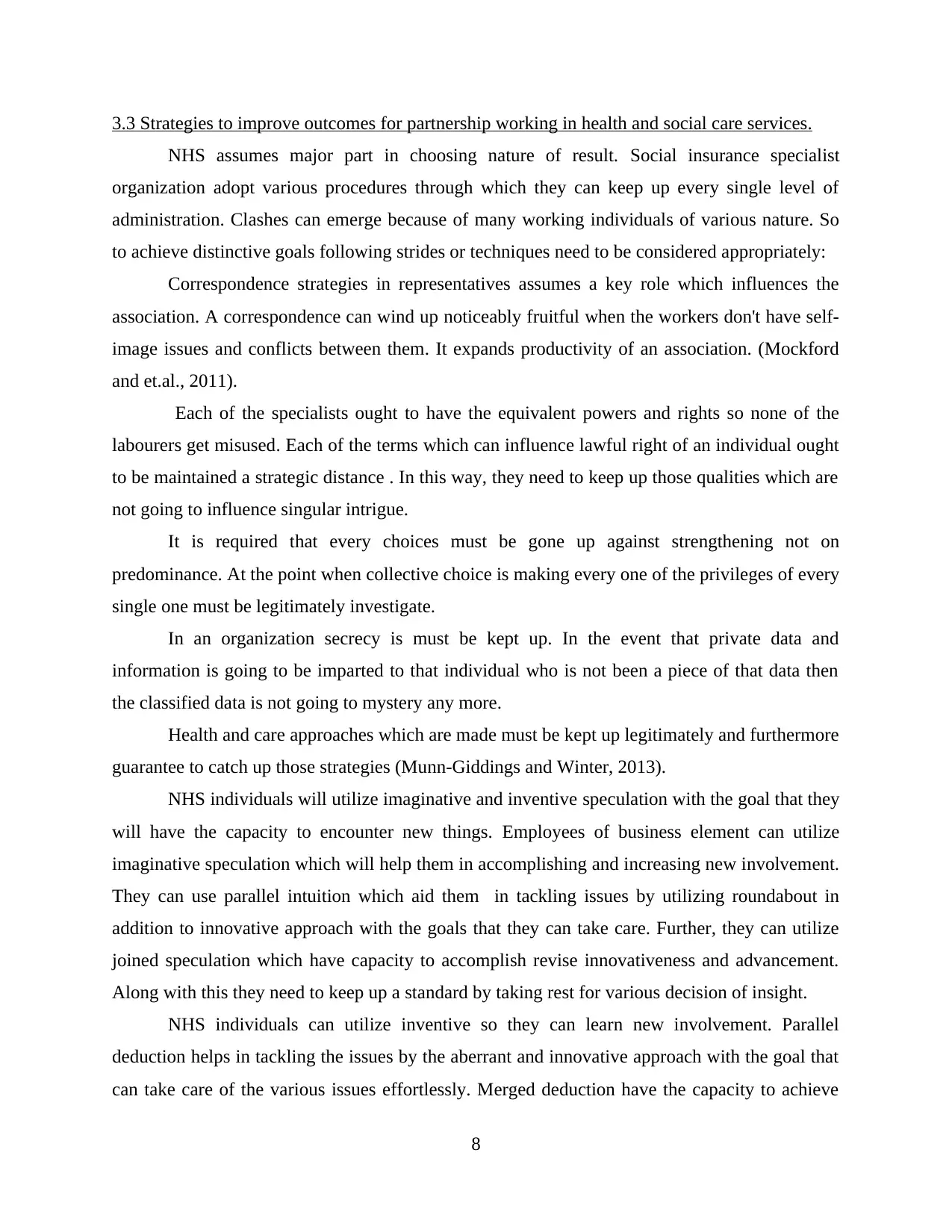
3.3 Strategies to improve outcomes for partnership working in health and social care services.
NHS assumes major part in choosing nature of result. Social insurance specialist
organization adopt various procedures through which they can keep up every single level of
administration. Clashes can emerge because of many working individuals of various nature. So
to achieve distinctive goals following strides or techniques need to be considered appropriately:
Correspondence strategies in representatives assumes a key role which influences the
association. A correspondence can wind up noticeably fruitful when the workers don't have self-
image issues and conflicts between them. It expands productivity of an association. (Mockford
and et.al., 2011).
Each of the specialists ought to have the equivalent powers and rights so none of the
labourers get misused. Each of the terms which can influence lawful right of an individual ought
to be maintained a strategic distance . In this way, they need to keep up those qualities which are
not going to influence singular intrigue.
It is required that every choices must be gone up against strengthening not on
predominance. At the point when collective choice is making every one of the privileges of every
single one must be legitimately investigate.
In an organization secrecy is must be kept up. In the event that private data and
information is going to be imparted to that individual who is not been a piece of that data then
the classified data is not going to mystery any more.
Health and care approaches which are made must be kept up legitimately and furthermore
guarantee to catch up those strategies (Munn-Giddings and Winter, 2013).
NHS individuals will utilize imaginative and inventive speculation with the goal that they
will have the capacity to encounter new things. Employees of business element can utilize
imaginative speculation which will help them in accomplishing and increasing new involvement.
They can use parallel intuition which aid them in tackling issues by utilizing roundabout in
addition to innovative approach with the goals that they can take care. Further, they can utilize
joined speculation which have capacity to accomplish revise innovativeness and advancement.
Along with this they need to keep up a standard by taking rest for various decision of insight.
NHS individuals can utilize inventive so they can learn new involvement. Parallel
deduction helps in tackling the issues by the aberrant and innovative approach with the goal that
can take care of the various issues effortlessly. Merged deduction have the capacity to achieve
8
NHS assumes major part in choosing nature of result. Social insurance specialist
organization adopt various procedures through which they can keep up every single level of
administration. Clashes can emerge because of many working individuals of various nature. So
to achieve distinctive goals following strides or techniques need to be considered appropriately:
Correspondence strategies in representatives assumes a key role which influences the
association. A correspondence can wind up noticeably fruitful when the workers don't have self-
image issues and conflicts between them. It expands productivity of an association. (Mockford
and et.al., 2011).
Each of the specialists ought to have the equivalent powers and rights so none of the
labourers get misused. Each of the terms which can influence lawful right of an individual ought
to be maintained a strategic distance . In this way, they need to keep up those qualities which are
not going to influence singular intrigue.
It is required that every choices must be gone up against strengthening not on
predominance. At the point when collective choice is making every one of the privileges of every
single one must be legitimately investigate.
In an organization secrecy is must be kept up. In the event that private data and
information is going to be imparted to that individual who is not been a piece of that data then
the classified data is not going to mystery any more.
Health and care approaches which are made must be kept up legitimately and furthermore
guarantee to catch up those strategies (Munn-Giddings and Winter, 2013).
NHS individuals will utilize imaginative and inventive speculation with the goal that they
will have the capacity to encounter new things. Employees of business element can utilize
imaginative speculation which will help them in accomplishing and increasing new involvement.
They can use parallel intuition which aid them in tackling issues by utilizing roundabout in
addition to innovative approach with the goals that they can take care. Further, they can utilize
joined speculation which have capacity to accomplish revise innovativeness and advancement.
Along with this they need to keep up a standard by taking rest for various decision of insight.
NHS individuals can utilize inventive so they can learn new involvement. Parallel
deduction helps in tackling the issues by the aberrant and innovative approach with the goal that
can take care of the various issues effortlessly. Merged deduction have the capacity to achieve
8
Paraphrase This Document
Need a fresh take? Get an instant paraphrase of this document with our AI Paraphraser
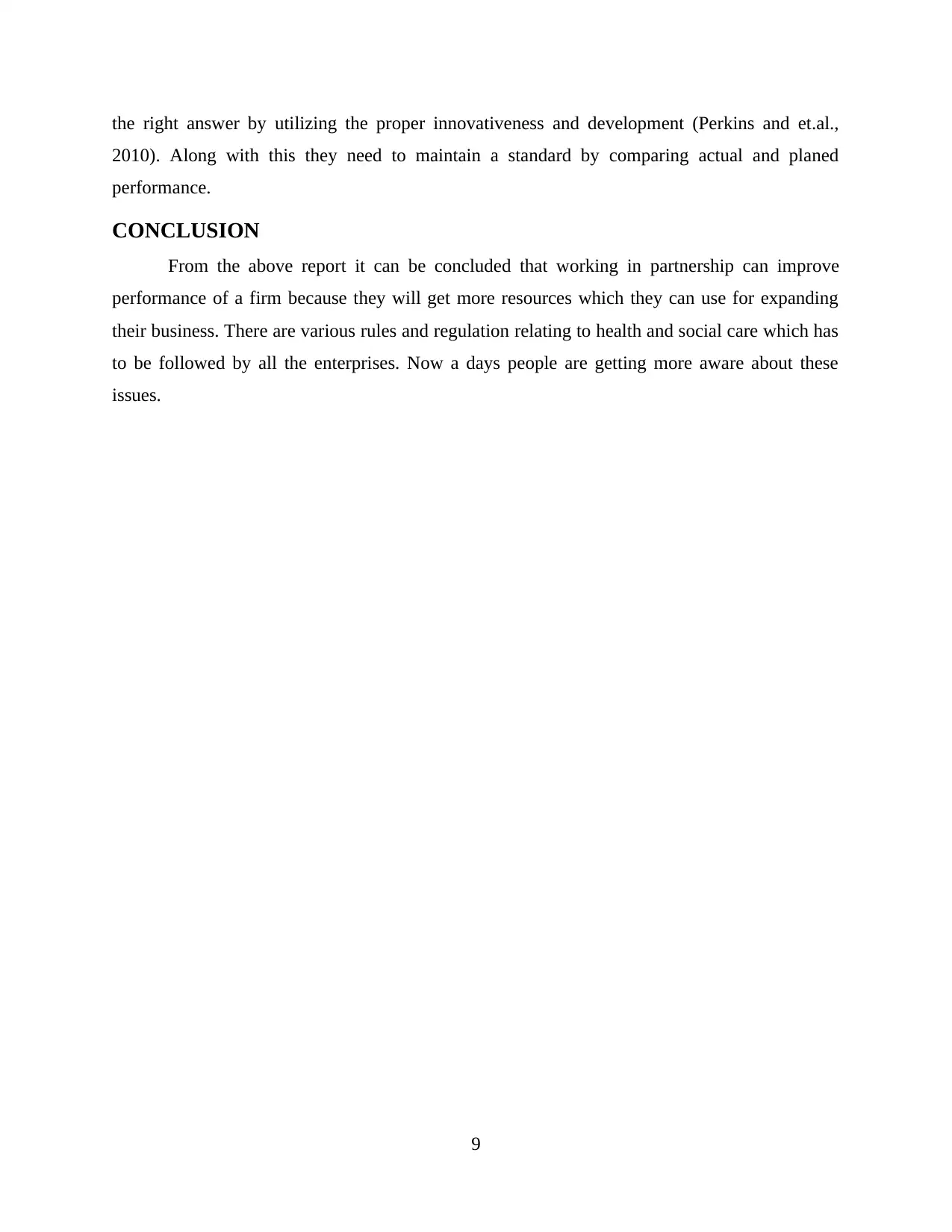
the right answer by utilizing the proper innovativeness and development (Perkins and et.al.,
2010). Along with this they need to maintain a standard by comparing actual and planed
performance.
CONCLUSION
From the above report it can be concluded that working in partnership can improve
performance of a firm because they will get more resources which they can use for expanding
their business. There are various rules and regulation relating to health and social care which has
to be followed by all the enterprises. Now a days people are getting more aware about these
issues.
9
2010). Along with this they need to maintain a standard by comparing actual and planed
performance.
CONCLUSION
From the above report it can be concluded that working in partnership can improve
performance of a firm because they will get more resources which they can use for expanding
their business. There are various rules and regulation relating to health and social care which has
to be followed by all the enterprises. Now a days people are getting more aware about these
issues.
9
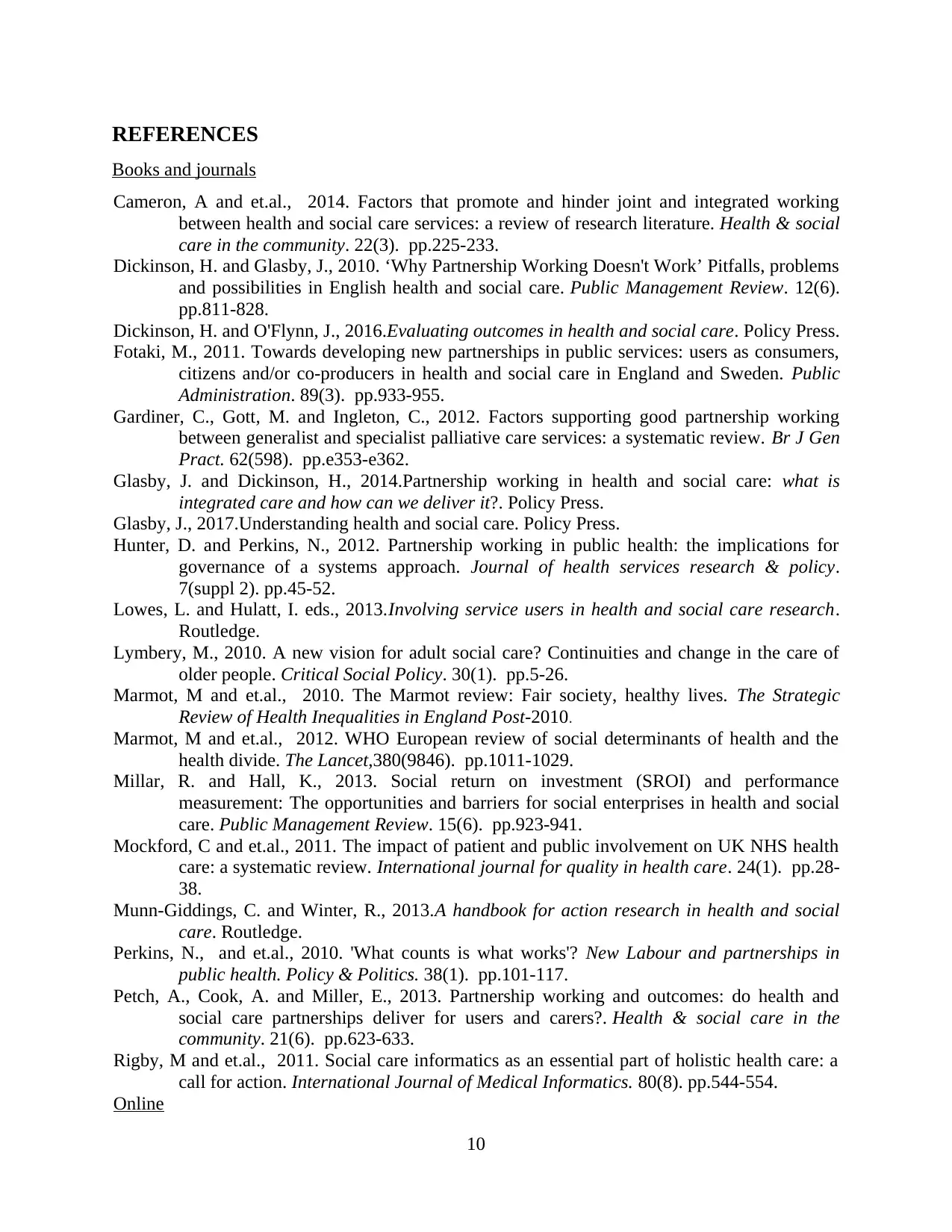
REFERENCES
Books and journals
Cameron, A and et.al., 2014. Factors that promote and hinder joint and integrated working
between health and social care services: a review of research literature. Health & social
care in the community. 22(3). pp.225-233.
Dickinson, H. and Glasby, J., 2010. ‘Why Partnership Working Doesn't Work’ Pitfalls, problems
and possibilities in English health and social care. Public Management Review. 12(6).
pp.811-828.
Dickinson, H. and O'Flynn, J., 2016.Evaluating outcomes in health and social care. Policy Press.
Fotaki, M., 2011. Towards developing new partnerships in public services: users as consumers,
citizens and/or co‐producers in health and social care in England and Sweden. Public
Administration. 89(3). pp.933-955.
Gardiner, C., Gott, M. and Ingleton, C., 2012. Factors supporting good partnership working
between generalist and specialist palliative care services: a systematic review. Br J Gen
Pract. 62(598). pp.e353-e362.
Glasby, J. and Dickinson, H., 2014.Partnership working in health and social care: what is
integrated care and how can we deliver it?. Policy Press.
Glasby, J., 2017.Understanding health and social care. Policy Press.
Hunter, D. and Perkins, N., 2012. Partnership working in public health: the implications for
governance of a systems approach. Journal of health services research & policy.
7(suppl 2). pp.45-52.
Lowes, L. and Hulatt, I. eds., 2013.Involving service users in health and social care research.
Routledge.
Lymbery, M., 2010. A new vision for adult social care? Continuities and change in the care of
older people. Critical Social Policy. 30(1). pp.5-26.
Marmot, M and et.al., 2010. The Marmot review: Fair society, healthy lives. The Strategic
Review of Health Inequalities in England Post-2010.
Marmot, M and et.al., 2012. WHO European review of social determinants of health and the
health divide. The Lancet,380(9846). pp.1011-1029.
Millar, R. and Hall, K., 2013. Social return on investment (SROI) and performance
measurement: The opportunities and barriers for social enterprises in health and social
care. Public Management Review. 15(6). pp.923-941.
Mockford, C and et.al., 2011. The impact of patient and public involvement on UK NHS health
care: a systematic review. International journal for quality in health care. 24(1). pp.28-
38.
Munn-Giddings, C. and Winter, R., 2013.A handbook for action research in health and social
care. Routledge.
Perkins, N., and et.al., 2010. 'What counts is what works'? New Labour and partnerships in
public health. Policy & Politics. 38(1). pp.101-117.
Petch, A., Cook, A. and Miller, E., 2013. Partnership working and outcomes: do health and
social care partnerships deliver for users and carers?. Health & social care in the
community. 21(6). pp.623-633.
Rigby, M and et.al., 2011. Social care informatics as an essential part of holistic health care: a
call for action. International Journal of Medical Informatics. 80(8). pp.544-554.
Online
10
Books and journals
Cameron, A and et.al., 2014. Factors that promote and hinder joint and integrated working
between health and social care services: a review of research literature. Health & social
care in the community. 22(3). pp.225-233.
Dickinson, H. and Glasby, J., 2010. ‘Why Partnership Working Doesn't Work’ Pitfalls, problems
and possibilities in English health and social care. Public Management Review. 12(6).
pp.811-828.
Dickinson, H. and O'Flynn, J., 2016.Evaluating outcomes in health and social care. Policy Press.
Fotaki, M., 2011. Towards developing new partnerships in public services: users as consumers,
citizens and/or co‐producers in health and social care in England and Sweden. Public
Administration. 89(3). pp.933-955.
Gardiner, C., Gott, M. and Ingleton, C., 2012. Factors supporting good partnership working
between generalist and specialist palliative care services: a systematic review. Br J Gen
Pract. 62(598). pp.e353-e362.
Glasby, J. and Dickinson, H., 2014.Partnership working in health and social care: what is
integrated care and how can we deliver it?. Policy Press.
Glasby, J., 2017.Understanding health and social care. Policy Press.
Hunter, D. and Perkins, N., 2012. Partnership working in public health: the implications for
governance of a systems approach. Journal of health services research & policy.
7(suppl 2). pp.45-52.
Lowes, L. and Hulatt, I. eds., 2013.Involving service users in health and social care research.
Routledge.
Lymbery, M., 2010. A new vision for adult social care? Continuities and change in the care of
older people. Critical Social Policy. 30(1). pp.5-26.
Marmot, M and et.al., 2010. The Marmot review: Fair society, healthy lives. The Strategic
Review of Health Inequalities in England Post-2010.
Marmot, M and et.al., 2012. WHO European review of social determinants of health and the
health divide. The Lancet,380(9846). pp.1011-1029.
Millar, R. and Hall, K., 2013. Social return on investment (SROI) and performance
measurement: The opportunities and barriers for social enterprises in health and social
care. Public Management Review. 15(6). pp.923-941.
Mockford, C and et.al., 2011. The impact of patient and public involvement on UK NHS health
care: a systematic review. International journal for quality in health care. 24(1). pp.28-
38.
Munn-Giddings, C. and Winter, R., 2013.A handbook for action research in health and social
care. Routledge.
Perkins, N., and et.al., 2010. 'What counts is what works'? New Labour and partnerships in
public health. Policy & Politics. 38(1). pp.101-117.
Petch, A., Cook, A. and Miller, E., 2013. Partnership working and outcomes: do health and
social care partnerships deliver for users and carers?. Health & social care in the
community. 21(6). pp.623-633.
Rigby, M and et.al., 2011. Social care informatics as an essential part of holistic health care: a
call for action. International Journal of Medical Informatics. 80(8). pp.544-554.
Online
10
⊘ This is a preview!⊘
Do you want full access?
Subscribe today to unlock all pages.

Trusted by 1+ million students worldwide
1 out of 13
Related Documents
Your All-in-One AI-Powered Toolkit for Academic Success.
+13062052269
info@desklib.com
Available 24*7 on WhatsApp / Email
![[object Object]](/_next/static/media/star-bottom.7253800d.svg)
Unlock your academic potential
Copyright © 2020–2025 A2Z Services. All Rights Reserved. Developed and managed by ZUCOL.





